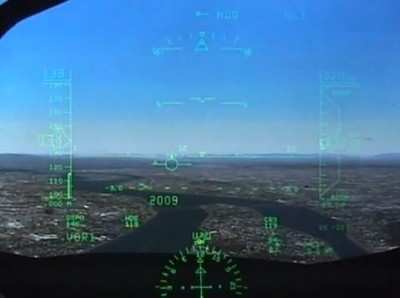Flight Safety Foundation Report Shows Systems Like HGS Could
Have Helped Prevent Them
 According to a study conducted by the Flight Safety Foundation,
head-up guidance system technology could have prevented or
positively influenced 38 percent of all commercial aircraft
accidents that occurred over the past 13 years.
According to a study conducted by the Flight Safety Foundation,
head-up guidance system technology could have prevented or
positively influenced 38 percent of all commercial aircraft
accidents that occurred over the past 13 years.
"Head-up Guidance Technology - A clear path to increasing flight
safety," is an independent third party study that examines use of
head-up guidance system technology in modern cockpits based on
digital technology. Commissioned by Rockwell Collins, the report
was derived through analysis performed by the Flight Safety
Foundation on information from 983 commercial air carrier, business
and corporate airline accidents during the 13-year period between
1995 and 2007.
Findings also indicated that the benefits of head-up guidance
technology increased in accidents where the pilot was directly
involved, such as take-off and landing and loss-of-control
accidents. In take-off and landing, the likelihood of accident
prevention is 69 percent when a plane is equipped with head-up
guidance technology. During loss-of-control accidents, the
likelihood of accident prevention is 57 percent.
 "Head-up guidance systems technology is a great safety tool for
the prevention of runway excursions, loss of control, and approach
and landing accidents," said Bob Vandel, foundation fellow for
Flight Safety Foundation. Vandel co-authored the study with Earl
Weener, Ph.D. and foundation fellow. "This technology provides
extremely useful data to the flight deck crew which allows them to
be the pilot they always thought they were."
"Head-up guidance systems technology is a great safety tool for
the prevention of runway excursions, loss of control, and approach
and landing accidents," said Bob Vandel, foundation fellow for
Flight Safety Foundation. Vandel co-authored the study with Earl
Weener, Ph.D. and foundation fellow. "This technology provides
extremely useful data to the flight deck crew which allows them to
be the pilot they always thought they were."
Rockwell Collins HGS displays critical flight information in the
pilot's forward field-of-view, eliminating the need for the pilot
to repeatedly transition between the head-down instruments and the
forward view through the windshield. As a result, pilots can keep
their attention focused on the outside world, enhancing overall
situational awareness and safety.
While seeming a bit like conclusions in search of supporting
data ... the study did find that the most important information on
the HGS display was consistently the flight path and speed error
information, which provides the pilot with the instantaneous energy
state of the aircraft and allows the pilot to see where the
aircraft will be while maintaining an 'eyes out' view.

"This report underscores the importance of head-up guidance
technology on board modern aircraft," said David Austin, senior
director, HGS at Rockwell Collins. "Our customers have always
recognized the situational awareness benefits of HGS technology.
However, this study goes further to underscore the critical safety
value of HGS technology and the benefits of keeping the pilot in
the loop even while aircraft become more automated."
The original Flight Safety Foundation report, "Head-up Guidance
Technology - A Powerful Tool for Accident Prevention," was
published in 1990. Rockwell Collins requested the Flight Safety
Foundation update this study to reflect new glass cockpit
technology most aircraft fly with in today's modern airspace.
 Airborne-Flight Training 05.09.24: ERAU at AIAA, LIFT Diamond Buy, Epic A&P
Airborne-Flight Training 05.09.24: ERAU at AIAA, LIFT Diamond Buy, Epic A&P ANN's Daily Aero-Term (05.07.24): Hazardous Weather Information
ANN's Daily Aero-Term (05.07.24): Hazardous Weather Information Aero-News: Quote of the Day (05.07.24)
Aero-News: Quote of the Day (05.07.24) NTSB Final Report: Cessna 150
NTSB Final Report: Cessna 150 Aero-News: Quote of the Day (05.08.24)
Aero-News: Quote of the Day (05.08.24)





